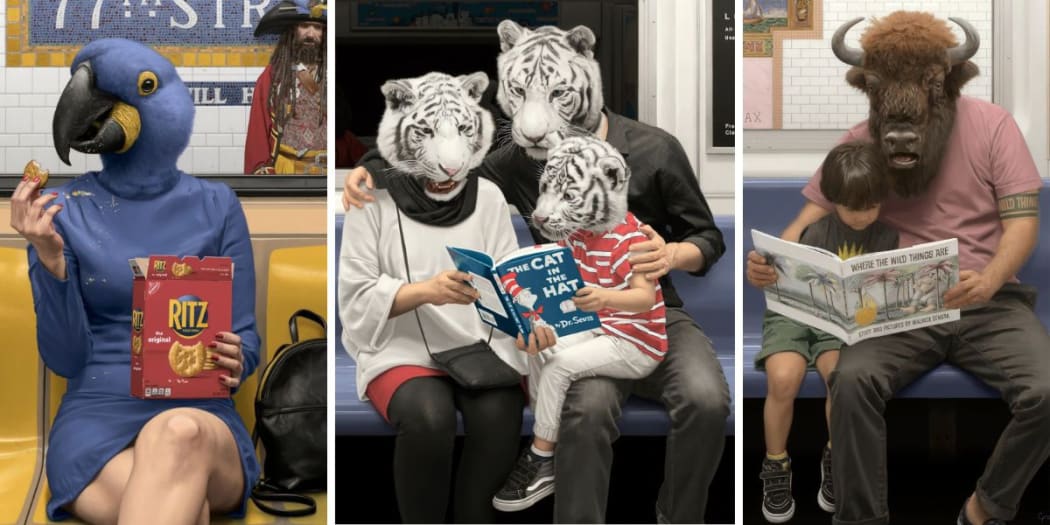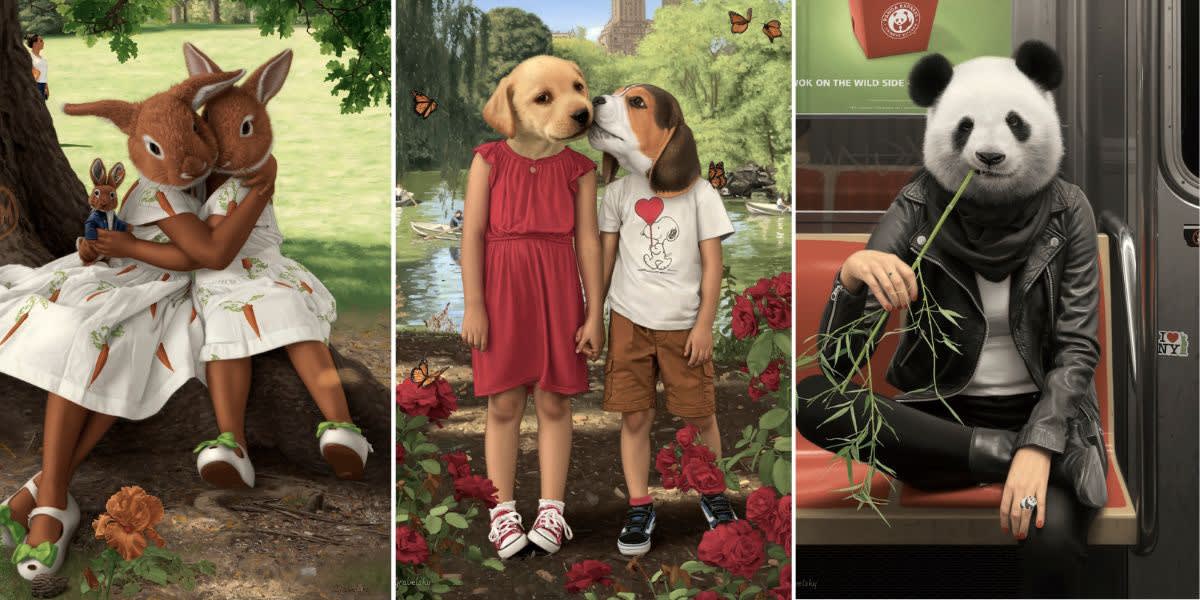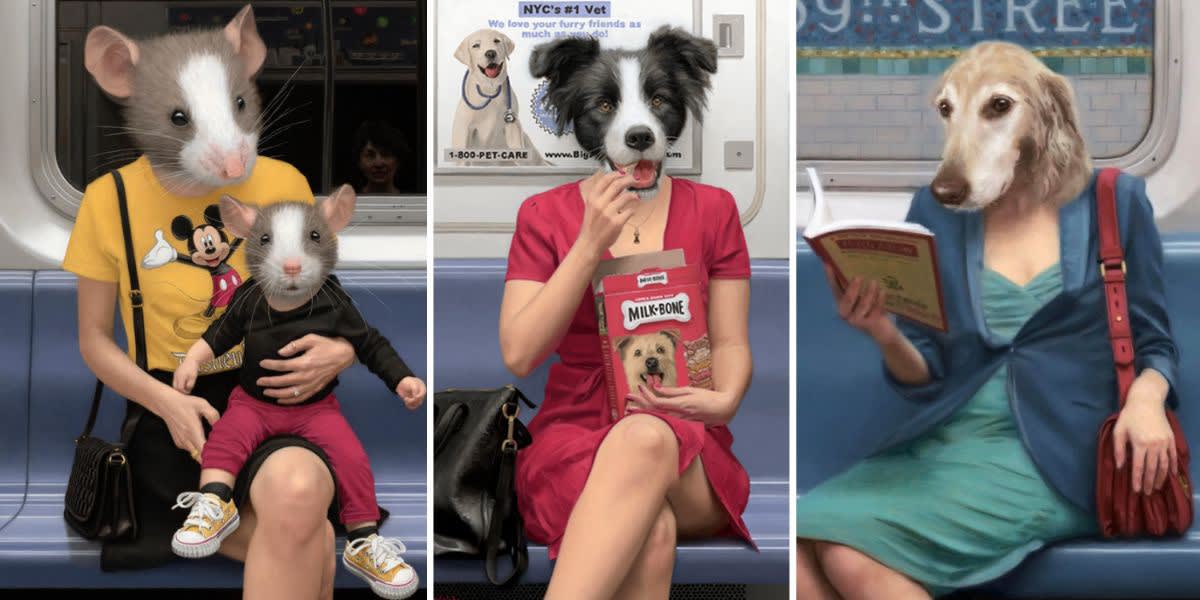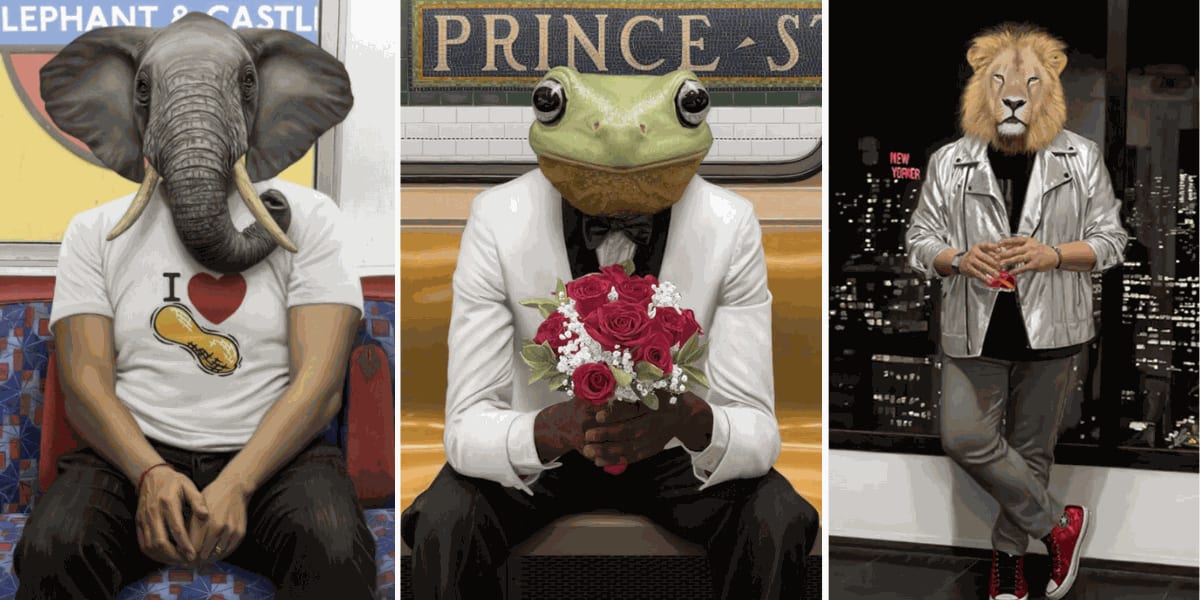

1) Your works often take place in the subway or in the everyday public spaces. How and what specifically about the urban context of New York has influenced your depiction of human-animal figures, and what role do these spaces play in the narrative of your works?
I grew up in New York City and I see it as the archetypical urban environment. When I first started my animal series I was living in Paris. I had already done some painting that involved mythology and I was looking to introduce those ideas into a contemporary setting. While I found Paris to be an incredibly beautiful city, most of the architecture dated from the 19th century and earlier and I thought having my paintings set there would make them look like they took place in the past. New York by contrast felt completely contemporary.
New York is an interesting place to use as a setting because it’s incredibly varied. Nearly every street and building looks different. As a dense urban environment, it’s the perfect place to put my characters. With just a small area of background surrounding the figures, you can instantly tell where they are. I live in Los Angeles now and while LA has some visually arresting landscape views, it’s a car city so most places you look you see empty streets. In New York, by contrast, you see people almost everywhere.
The first animal painting I made was set on the New York subway and for years that was the primary location for my work. Along with my subway paintings, I’ve made a number of pieces set on New York streets and in its parks. I’ve been thinking more and more about where my characters go when they get off the subway and moving forward, that’s where I’m planning on focusing my work.
2) In your paintings, animals seem to embody the hidden aspects of the human psyche. Could you share some examples of how you choose which animal to represent and what subjective or collective meaning it might have?
In my painting “The Panda Express,” I had the idea to paint my friend with a panda head chewing on bamboo. I’ve used food many times in my paintings as a funny way to connect to how the animal lives. To enhance the sense that she embodied a panda, I asked her to dress in black and white to match the coloring of a panda’s body.
In “Polly Wants a Cracker,” a girl with a parrot head is eating Ritz Crackers. This is inspired by the famous saying “Polly wants a cracker” dating from an old Nabisco ad campaign for crackers. As she snacks on the crackers, crumbs fall onto her dress to suggest the messy way parrots eat. Similar to the panda piece, I painted her in a bright blue dress to match the colors of the specific parrot, the Hyacinth Macaw, that I depicted her as. To complete the scene, I placed a pirate outside the train car to reference the way pirates are often thought to have kept parrots as pets.
In “The Cat in the Hat,” a family with white tiger heads reads the Dr. Seuss book of the same name. I chose white tigers to go with the book because I wanted wild cats and thought that their black and white coloration nicely matched the cat in the book. Tigers are often thought of as ferocious animals because they’re apex predators. However, mother tigers are very gentle with their cubs. For this painting, I liked the idea of capturing these fearsome predators in a tender familial moment.

3) Your technique is inspired by 19th-century academic and naturalist painters, yet there's a clear surreal touch. How do you maintain detailed realism while introducing fantastical elements that defy logic?
My goal is to create an image that looks real but not exactly realistic. I start with an idea, then collect lots of reference material. I photograph friends and family members for the characters. I take photos of the subway or other settings to help create the backgrounds. I get other photos of animals and the details that I want to add to the scene. Sometimes I will make small models to see what the lighting and shadows would look like. From there I make pencil and oil sketches as well as a mockup in Photoshop to visualize what the scene will look like in detail. Once that’s all done, I transfer a full-scale drawing to the canvas and start painting using the reference material to render everything convincingly.
4) Your subjects are often portrayed engaging in everyday activities, such as reading newspapers or magazines. How did you develop this theme, and what does this overlay of stories from the real and surreal present, transposed onto canvas, and the mysterious stories that your characters are reading represent to you?
I’m constantly drawing from memory and my childhood to create my paintings. My parents read to me all the time when I was a kid and as is common in children’s books, most of them had fantastical elements. This is the inspiration for all the children’s books in my work. Additionally, the books, magazines, and newspapers, give a window into what is going on in the minds of the characters. By showing you what they’re reading you get insight into what they’re thinking about.

5) Reflecting on the persistence of animal imagery in mythology and collective imagination, how do you think contemporary culture influences or changes our interpretation of these classical symbols?
Animal imagery in mythology dates back to the very earliest stories that survive. Mythology fascinates me because it’s a collection of common stories that are told over and over and continue to evolve. These stories are shared by large groups of people and accrue meaning as they’re passed on. While many of the old stories are still relevant today, some fade from the collective consciousness while we keep inventing new ones.
I see the stories from pop culture as our modern mythology. These include comic books like Batman, Disney films like The Lion King, and many more. Like the old mythological tales, these are told over and over and continue to evolve. Batman has been portrayed by many comic book writers and artists as well as by many actors and directors. Likewise, The Lion King changed as it moved from the original animated film to the Broadway stage to the live-action film version. That’s why I often introduce elements and characters from pop culture into my paintings. I feel that they add meaning to my paintings and connect them to the long line of mythological storytelling.
6) The idea of a "prolonged suspension of disbelief" that your works evoke... What reaction or feeling do you imagine and hope to stir in viewers as they observe these unlikely yet convincing scenes?
I’ve always been drawn to paintings that are somewhat ambiguous versus overly didactic ones. When the artist is telling me want to think I’m bored. I’m most interested in works that give a jumping-off point to engage my imagination. This way they feel interactive. That’s the experience I would like people to get from my work. Sometimes people tell me that they don’t know if this is what I’m trying to say but this is what they see in my paintings. When I hear that I feel that a piece has succeeded because I know they engaged with it and it triggered their imagination to come up with meaning or a story of their own.
On another note, humor plays a big role in how I think about my work. I’ve always loved visual humor and most often it’s a funny thought that’s the initial spark for one of my paintings. I love combining strange humorous imagery with a meticulously painted technique generally associated with serious things. I also think a lot about the dynamic between tragedy and comedy. They’ve always been two sides of a coin but in the contemporary world, works that evoke tragedy are often taken more seriously. While there are a lot of works that fall under tragedy that I love, I often find it’s an easy way to make something that appears important. Depict something sad or depressing and that’s all you have to do. Good comedy, however, while appearing light-hearted, is extremely difficult to pull off. Thus, if someone looks at my paintings and they laugh, I’m happy.

7) Considering the almost mythological nature of your hybrid creatures, if you were to add a new perceptive layer to your works through another form of art, what form would you want them to take?
I’ve always loved marble sculptures of mythological characters. I lived in Europe for years and they were everywhere. The characters seemed like they were alive but frozen at some perfect moment in their story. I’ve always thought that marble was one of the most beautiful materials. White but full of character, sometimes smooth, sometimes slightly rough and sparkly, crisscrossed with subtle veins and color changes. I spent years as a sculptor until college when I started painting. I’ve used many different sculptural materials but never marble so I’d love to render one of my characters in marble one day.
8) As an observer of social behavior through your artwork, what is your perception of today's society, and how does that view shape the characters and scenes you depict?
I think it’s really difficult to define what society is like in the time that you’re living. Of course, you can make observations and write about it but I think there is a clarity looking back at other time periods that you don’t have for the one you’re in. Therefore, my approach isn’t to come to some grand thesis about what contemporary life is. Rather I like to show close-up vignettes of specific characters taken from the world around me and suggest they are part of a much larger world. I leave it to the viewer to determine if all these snapshots add up to something bigger.

9) Do you often find inspiration from specific people you encounter on the street or in the subway to create your artworks? Or are your semi-human, semi-animal creatures more often the product of your imagination?
Most often an idea will pop into my head and it will make me laugh. This almost always happens at off moments when I’m not focusing on something in particular such as waking up, taking a shower, exercising, etc. Then I’ll think about which of my friends or family members would best embody the character I imagine. At that point, I have them model for me and their personality and style combine with my idea to create the character. Next, as I’m working out the composition and then working on the painting itself, I’ll get ideas for specific details related to the character that I add in.
10) Among all the animals you paint, is there perhaps one that you feel represents you the most? If so, which one? And why?
I’ve been obsessed with raccoons for a while. One used to sleep on the giant bougainvillea outside my studio window during the day and it started to feel like a painting companion. If you observe them you’ll see how curious they are and how they use their hands in an almost human way. This made me think that raccoons would be a great representation of the qualities of a painter who also works with their hands and curiosity. I’m planning on doing a self-portrait as a raccoon at some point.

11) The color palette of your works is always very vibrant and varied. Why this choice? Is there something you want to convey through this choice of colors?
Color is the element of painting that is most effective at creating a sense of emotion and my goal is to use it to draw the viewer into the world that I’m depicting. I’ve always suspected that the color schemes that elicit strong emotions are effective because of the feelings they conjure up from seeing them in the natural world. Blue and orange are the colors of the sunrise and sunset and so they evoke feelings of those times of day. Red and green are beautiful because we see them in nature in the petals and leaves of a rose. Grey-blue suggests the colors of the snow and water on cold days while bright blue-green makes us think of warm tropical waters. Orange makes us think of fire which thus of warmth.
I always start with a composition by working with light and dark shapes without any color. Once I’ve created an effective composition in just black and white I introduce color. Sometimes I’ll pick a color scheme simply because it’s visually appealing and makes me want to look at the painting. Other times I’ll choose one to elicit a certain mood to go with the story in the painting.
12) Many of your works depict a human figure alongside a semi-human, semi-animal figure, portrayed as if they were a couple or friends, with a close bond between them. What is the message of these works? Do you aim to represent the close bond between humans and nature, and therefore animals, through this?
I always paint one or more of the subjects as having an animal head while the rest of the world that they inhabit is filled with normal humans. I see the animal head as representing a transformation that captures something of the psychology of the subject. I like it to be ambiguous whether the painting actually shows a fantasy where the person has an animal head or if it is actually all going on in their minds. I leave it to the viewer to decide what they think.
I have always been fascinated by the natural world and the animal kingdom. It’s filled with such an enormous diversity of animals of which we are one. There is a deep human instinct to anthropomorphize animals that runs from the oldest recorded stories and art through contemporary ones such as The Lion King. In many ways, animals have similar traits to us while in others they are completely different. By combining animals and humans I am trying to show that dichotomy. At the same time, there is something strange and interesting that happens when I paint an animal head realistically on a human body and that is enough by itself without having a specific thesis about what it means.on.


